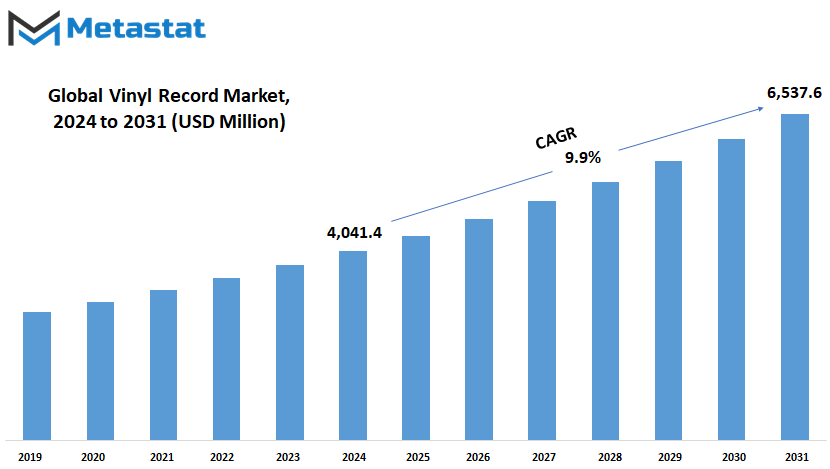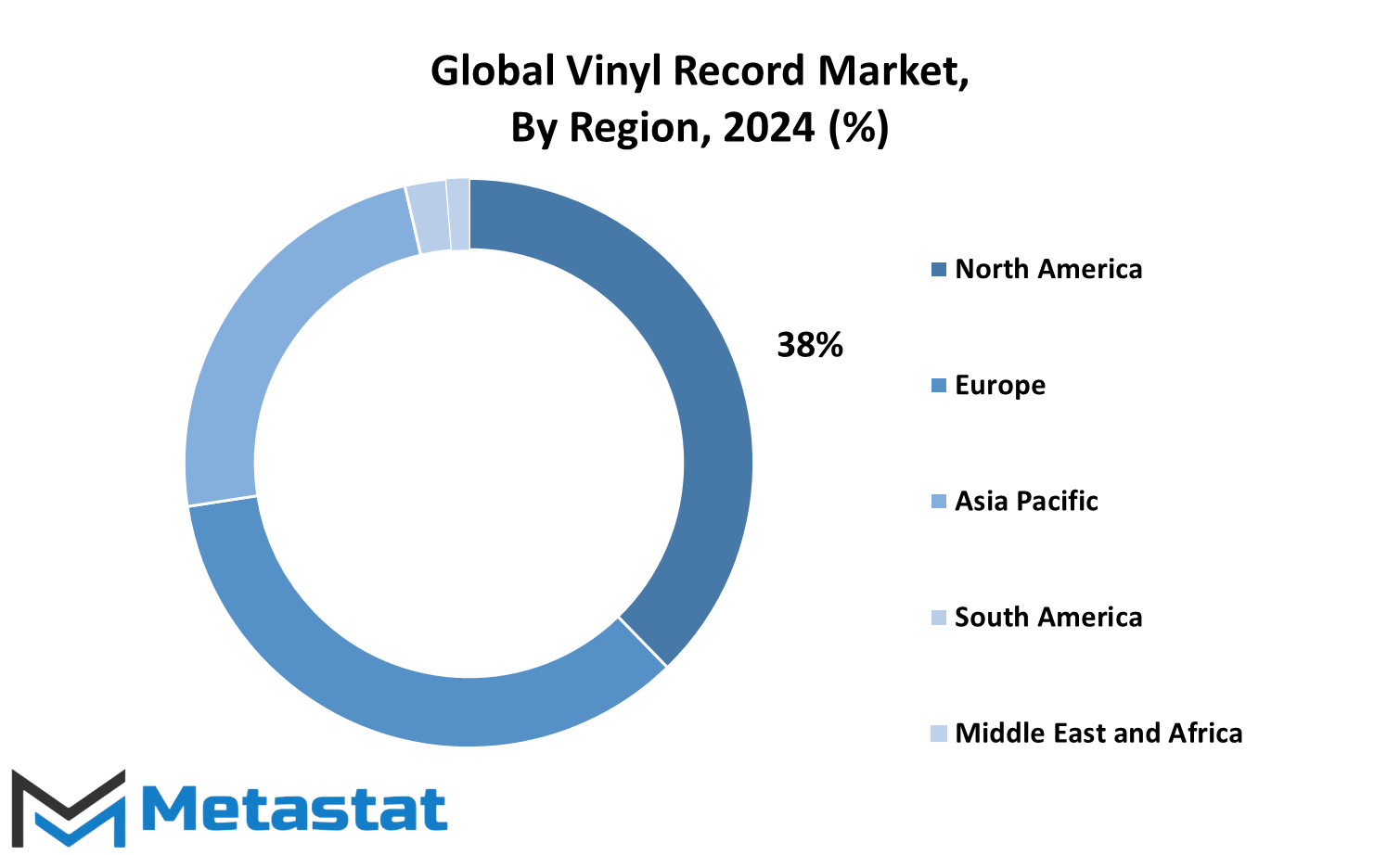MARKET OVERVIEW
The Global Vinyl Records market is an exclusive industry niche focused on the manufacturing, distribution, and consumption of vinyl records-these days, that format has been steadily gaining ground in popularity. It reaches very diverse groups, from an audiophile who pays for the best quality sound to vinyl records collectors or indeed anyone wishing to own physical media with aesthetic value. It truly embodies a kind of cultural nostalgia mixed with more contemporary tastes in music, thus making it a unique niche within the broader spectrum of music and entertainment.
Vinyl records were first introduced mid-20th century, was gradually substituted with newer formats, like CDs and digital downloads. However, in the past decades vinyl re-emerged as a sought-after format, giving listeners a concrete connection to music. The renewed interest takes its fuel in this Global Vinyl Records market and is seen to value warmth and authenticity of sound compared to other modes of audio as it is perceived to be richer and more immersive than digital audio. A growing demand for turntables, record players and the accessories which are needed in the vinyl ecosystem further fuel this preference.
It stretches from geographies: historically, the main markets that have participated are those in North America and Europe-the places with established music industries and strong consumers. Asian and South American markets are gradually gaining interest in vinyl records due to the newer generations embracing the retro aesthetic and the older generations rediscovering a medium they used to love. This makes it highly likely to find the vinyl records industry in independent music stores, mainstream retail chains, and other online marketplaces, thus being more accessible to different audiences.
The global Vinyl Records market is still diverse, with different styles and genres that reflect the multiple tastes of listeners worldwide. From classic rock and jazz to contemporary hip-hop or indie music, vinyl records are produced for nearly every musical preference. Further, limited edition releases, colored vinyl, and box sets give the market a collectible appeal that draws the fans and collectors willing to spend more for the rare items. This makes vinyl different from other formats because ownership in the physical sense and designs on the packaging determine much of how appealing it will be to the consumer.
Improved production and distribution flow in the market will be impacted by technological advances. Better pressing techniques, superior package design concepts, and advancements in record players can polish the overall vinyl experience further. Digital channels will support their value propositions well enough for labels and artists to promote vinyl releases toward wider audiences. Elements both physical and digital mixed together are likely to cement relevance within the market.
Environmental considerations will also shape the future of the global Vinyl Records market. Efforts to conserve natural resources and increase each industry’s concern for being both “green” and sustainable will begin to be increasingly incorporated into vinyl record production. Among these potential developments could be recycled vinyl; biodegradable packaging; and a reduction in energy use in manufacturing.
The Global Vinyl Records market stands unique, that at the same time is a badge of tradition and now holds contemporary significance. Ahead of consumer preferences and technology, the market has the promise of change and growth, thereby enabling vinyl records to be cherished for even more generations in a dynamic musical landscape. This feature of being rooted in the past and adding innovation would stand out as its strength in that part of the musical world.
Global Vinyl Records market is estimated to reach $6,537.6 Million by 2031; growing at a CAGR of 9.9% from 2024 to 2031.

GROWTH FACTORS
Global Vinyl Records Market is witnessing a revival, thanks to nostalgia and new consumer tastes. Old and vintage music in formats have captured the imagination of collectors and music enthusiasts for vinyl records, as a result of which there is an unrelenting demand for these records. The trend is a manifestation of a rising acceptance of tangible music experience in an otherwise digital consumerist world. The tactile feel of records combined with the audio quality has long since transcended the realm of only being a music medium; it is art and lifestyle for many.
Another reason that this market will continue to expand is the growth of vinyl presses as well as independent record labels. A few of these businesses appeal to a very niche audience: they may produce limited-edition releases and special reissues of out-of-print records that collectors highly value. Such niche channels of production will add to the consumer options and boost an interest in unique and rare vinyl offerings. Such a concentration on limited exclusive content has encouraged, both new and seasoned collectors, to be engaged with the market.
While it has picked up pace, vinyl records market does have its challenges. High production costs and longer manufacturing lead times continue to be significant barriers, especially when they compare the efficiency of digital music formats. Vinyl records need time and precision in their production. This limits scalability for manufacturers. The space required for production and distribution is often limited in a physical sense, an additional challenge for businesses looking to increase operations.
But the future is more promising for the market. Increasingly, online storefronts and platforms pop up for vinyl records, taking with them new outreach and engagement for more sales. Those internet forums give record collectors a wider access to whatever records they need and dynamize a community where music fans can meet and gather for more passion. The access port between buyer and seller can be online and could reach each region in the world, offering new customers and various opportunities.
It is basically about the need to feel and touch, carrying the appeal of vinyl records beyond just music. Of course, production costs and scalability are big problems in the short term; however, consumer interest in retro formats keeps growing, and there’s continued niche support from producers who recognize the virtues of this medium. With rapid growth in online platforms and an interested global audience, the future of the Global Vinyl Records market appears to be on a stable growth pattern, blending tradition with modern innovation into a wide range of products for enthusiastic consumers.
MARKET SEGMENTATION
BY Product Type
The global market for vinyl records is back in a boom, mingled not only with the nostalgia but more particularly and deeply with the desire to have something tangible that connects us to our music. It is not just a rediscovery of an old format; it is a burgeoning appreciation for the warmth and authenticity that vinyl brings to listening experiences that have been whipped to a frenzy by years of technologically-mediated music consumption where digital has dominated the industry. However, vinyl has found a way to coexist with these modern formats, carving out its unique space among collectors, enthusiasts, and even new generations of listeners.
Various products can be seen in the market for vinyl records, each meeting different tastes. LPs, or 33 RPM records, are the staple choice for full albums with extended playtime. 45 RPM singles are a format specifically for those track enthusiasts as they only provide focused material in smaller quantities, while older records (78 RPM) hold value in history for niche collectors and enthusiasts who may want to follow the track of recorded music evolution. An extended play falls between the single and the album; usually, artists use an EP to provide unique work or experimental pieces. These apart, the market stretches the format to include special editions and collector’s vinyl. Many of them contain limited releases with signed covers or special packaging that is extremely attractive to the fans. There is also the picture disc and colored vinyl record, which has been taken up by many as a form of art besides the audio. However, this trend shows an increasing need for vinyl records in terms of sound, artistry, and exclusivity.
The global vinyl records market is expected to continue growing in the future, on a combination of tradition and innovation. One may say that the more people are looking for unique, high-quality listening experiences, the more they prefer vinyl records. New trends may include such personalization as the use of customized designs or even further interactive features for the owner. Furthermore, the market may be sustainable as environmentally conscious consumers require environmentally friendly methods of production for vinyl products. The advancements in technology are likely to shape up the dynamics between analog and digital formats, but all that this means is that vinyl will be more secure as long as its appeal hasn’t diminished with time. Infusing timeless appeal with modern innovations, the global vinyl records market will thus remain vibrant and dear to music enthusiasts for years to come.
By Distribution Channel
The Global Vinyl Records market has seen significant growth in recent years because of nostalgia, and growing appreciation for better analog sound quality and shifting consumer preferences. It’s more than a fad; it’s a massive change in the way music enthusiasts interact with physical media. Technological improvements of production and access have made the channels through which the product is delivered more diversified but still sensitive to the history of music and tradition that these institutions have built.
Record stores and other comparable physical retailing channels are also critical. Such shops are, in essence, local cultural spaces where the consumers can browse collections to find music that gives them a chance to relate to records personally. For most customers, at least, browsing through shelves for unknown treasures cannot be replaced; therefore, these firms remain spearheads of the market. Balancing with the specialty shops, the former having available rare and collectible vinyl records, attracts fans who value distinctness and history.
On the other hand, the development of online retailers has facilitated the general marketability of vinyl records worldwide. Convenience and plenty are key benefits available on most e-commerce sites, ranging from popular to obscure releases. In fact, many of the websites specialize in targeting the younger demographic, who prefer ease of purchase and delivery. Artist websites are also seeing high growth rates through direct-to-consumer channels. Artists and bands also use the channels to establish direct communication with the audience. Many signed records and edition records are exchanged for love value.
As a form of dynamic promotion and sales, music festivals and events have become a natural outlet for selling vinyl records. Such events are commonly attended by music enthusiasts, creating an ideal venue for artists and record labels to offer their goods. Subscription-based services are also revolutionizing the way people seek and build their collections of vinyl. These services bring subscribers curated selections, generating anticipation and discovery.
Resale and second-hand markets are added value to the burgeoning industry. By enabling collectors to buy and sell pre-owned records, these channels extend the life of vinyl albums, significantly reducing waste and making vinyl more accessible to budget-minded people. It’s a segment that particularly attracts environmentally conscious buyers and record enthusiasts.
Going forward, the Global Vinyl Records market is likely to boom as tradition will now largely match progress. As the market embraces all physical and digital strategies, it is supposed to expand further while showcasing the eclecticism of vinyl records.
By End User
The Global Vinyl Records market continues growing strong; this is something unique about balancing nostalgia with innovation. Vinyl records have been eclipsed and dominated for decades by modern formats such as CDs and digital streaming, yet they have regained dominance over the past decade or so. This has been fueled by a steadily increasing interest in physical quality audio experiences that digital formats regularly struggle to offer. Beyond nostalgia, vinyl records appeal to a wide section of end-users having divergent needs and expectations that would influence market trends.
The biggest number is made up of individual consumers. Vinyl, after all, is most valuable to individual buyers as an auditory value as well as an aesthetic one. Owning a record collection became part of the cultural statement-in combining passion for music with personal style. DJs and music producers constitute another core demographic. For them, vinyl is not merely a source for playing the desired music but also an implementation tool for mixing and scratching in ways impossible with digital formats. In other words, it remains the only popular choice in this domain.
Audiophiles and collectors are yet another strong group that ensures demand for vinyl records. This is the part that literally enjoys high-quality sound effects and artful cover designs of albums, enriching the much-sought experience. Collectors often consider vinyl to be a sort of investment; hence, rare editions and limited releases come with premium prices. Just as that, event organizers are searching for new ways to integrate vinyl in their events: this enhances atmosphere and offers guests unique experiences. Some of the best bars and cafes that curate vinyl collections are very successful at creating unique spaces where music and ambiance come together. So even recording studios are part of the deal, where many artists want to release their work on vinyl to reach those audiences that prioritize quality over convenience. Entertainment venues go the same way, where vinyl often features prominently in efforts at creating a distinctive vibe. Corporate gifting and branding strategies have evolved with vinyl records as a creative way to stand out. Their customized versions, reflecting a company’s identity, turn out to be a beautiful way of getting in touch with the people.
Looking forward, market development into the future has bright prospects. Improvement of production technology and stable appreciation for analog formats will support further expansion. It is up to the various user groups to find new ways to incorporate vinyl records into their everyday lives and businesses; this trend will likely continue to evolve – into tradition intensified by modern creativity.
|
Report Coverage |
Details |
|
Forecast Period |
2024-2031 |
|
Market Size in 2024 |
$4,041.4 Million |
|
Market Size by 2031 |
$6,537.6 Million |
|
Growth Rate from 2024 to 2031 |
9.9% |
|
Base Year |
2022 |
|
Regions Covered |
North America, Europe, Asia-Pacific Green, South America, Middle East & Africa |
REGIONAL ANALYSIS
If the market is analyzed regionally, then it would be easy to figure out that the global vinyl records market is a diversified and dynamic space. In fact, all the key geographies are vastly different in terms of interest level, cultural factors influencing people, and consumer behavior. Every geography would contribute to the growth and sustainability of the vinyl records market.
North America emerges as a major player, with the United States leading in production, sales, and engagement by consumers. The U.S., Canada, and Mexico collectively support the region as a market for both the nostalgic vinyl collector and the contemporary collector. Countless reasons explain how vinyl is once again enjoying its position in North America, including a rich musical heritage and an ever-growing appetite for physical music formats that connect consumers to real art and culture.
Europe is the second largest region for the global vinyl records market. This area involves countries that include the United Kingdom, Germany, France, and Italy; it has a considerable market already, and there are waves of nostalgia and new age trends within this space. More so, the rest of Europe also mirrors steady demand that was really supported by strong cultural ties to music and renewed interest in analog audio formats. And once again, with the consumers of Europe increasingly seeking unique and quality music experiences, the vinyl record comes into this demand as synthesis of artistry and authenticity.
India, China, Japan, and South Korea are some of the Asia-Pacific countries with an expanding market for vinyl records. The upsurge in interest, here, is attributed to the younger segment of the population discovering this format once again and also to older listeners who still have a fondness for the old-school charm of vinyl. So far, Japan has maintained a strong relationship with vinyl culture for years; the rest of the continent is trying to catch up, fueled by rapid urbanization and increasing disposable incomes.
South America, including Brazil and Argentina, contributes to the market with its dynamic music traditions and a growing interest in the whole analog sound. The Rest of South America also promises great potential as regional artists and collectors embrace vinyl as a medium for artistic expression and preservation.
Potential exists in the Middle East & Africa region, with Egypt and South Africa leading the charge, as well as GCC countries, in exploring vinyl records as part of a growing niche market. As global trends intersect with local music scenes, this region is just beginning to come into play, making vinyl records more accessible and desirable. The world vinyl records market is thriving across all regions. Letting old appeal unite with newer consumer taste, it defines its space in the future of music consumption.

COMPETITIVE PLAYERS
The vinyl records market witnessed a wonderful revival globally over the last couple of years. Resurfacing nostalgia and innovation, vinyl records earlier were only perceived as a niche product distributed specifically to collectors and die-hard enthusiasts. However, over time, vinyl records have remained evergreen in popularity among mainstream consumers. Consequently, growing demand has created a competitive space for key players in this market as they tend to constantly meet the aspirations of consumers while embracing progress in the production techniques.
The leading companies within the industry, such as GZ Media, United Record Pressing, MPO International, and Optimal Media, have been on the cutting edge as regards tradition and modern needs. The companies manufacturing vinyl records are not just manufacturers of records but trailblazers in quality and efficiency. In each of the companies, there are unique strengths that bring an environment where innovation is the only path through which relevance can be held. For instance, the examples in Precision Record Pressing and Third Man Pressing operate under precision. Their mastery has produced quality at all levels, and companies like Viryl Technologies are creating further breakthrough technologies in the production manufacturing process that can advance production. A growing consumer base is a plus for the global vinyl records market, as younger generations can enjoy the tactile and auditory pleasure of vinyl. An increasingly wide range of genres fuels enthusiasm that boosts demand and spurs manufacturers to cater to different tastes. Companies such as Smashed Plastic and Erika Records have therefore capitalized on this trend by offering limited editions and pressings tailored for collectors and casual listeners.
Going forward, the technological edges may further sway how this market goes. As vinyl has so much charm in terms of its analog nature, companies like Zenith Records and Pheenix Alpha are evaluating methods to sustainably introduce green materials and green practices without compromising the quality of product. This will also resonate with those consumers who consider themselves environmentalistic and, therefore, could be a significant factor regarding market differentiation.
Competition between the market leaders is expected to rise in the wake of this growing popularity of vinyls across the globe. This may be beneficial for Quality Record Pressings and Memphis Record Pressing, who may increase their operations and build up capacities for production. Companies and artists may also begin to redefine creative boundaries related to vinyls which listeners can hear only in them but nowhere else-possibly in a manner that just cannot be replicated with digital reproduction.
The competitive players for the future of the global vinyl records market will exercise influence as it evolves. They will give impulse to make vinyl records remain popular as a treasured medium for a music lover through embracing innovation, maintaining the quality, and response in resonance with consumer demands.
Vinyl Records Market Key Segments:
By Product Type
- LP/33 RPM Vinyl Records
- 45 RPM Singles
- 78 RPM Records
- Extended Plays (EPs)
- Special Edition and Collector's Vinyl
- Picture Discs
- Colored Vinyl Records
By Distribution Channel
- Offline Retail (Record Stores)
- Online Retail (E-commerce Platforms)
- Direct-to-Consumer (Artist Websites)
- Music Festivals and Events
- Subscription-Based Platforms
- Specialty Stores (Antiques, Collectibles)
- Resale and Secondhand Markets
By End User
- Individual Consumers
- DJs and Music Producers
- Audiophiles and Collectors
- Event Organizers
- Recording Studios
- Entertainment Venues (e.g., Bars, Cafés with Vinyl Collections)
- Corporate Gifting and Branding
Key Global Vinyl Records Industry Players
- GZ Media
- United Record Pressing
- MPO International
- Optimal Media
- Record Industry
- Pallas Group
- Precision Record Pressing
- Third Man Pressing
- Quality Record Pressings (QRP)
- Key Production
- Memphis Record Pressing
- Viryl Technologies
- Smashed Plastic
- Erika Records
- Zenith Records
WHAT REPORT PROVIDES
- Full in-depth analysis of the parent Industry
- Important changes in market and its dynamics
- Segmentation details of the market
- Former, on-going, and projected market analysis in terms of volume and value
- Assessment of niche industry developments
- Market share analysis
- Key strategies of major players
- Emerging segments and regional growth potential








 US: +1 3023308252
US: +1 3023308252






